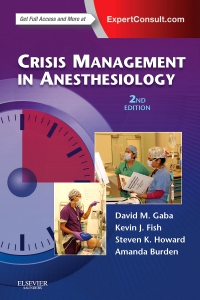
Crisis Management in Anesthesiology, 2nd Edition
Elsevier eBook on VitalSource

Now $68.39
The fully updated Crisis Management in Anesthesiology continues to provide updated insights on the latest theories, principles, and practices in anesthesiology. From anesthesiologists and nurse anesthetists to emergency physicians and residents, this medical reference book will effectively prepare you to handle any critical incident during anesthesia.
"A comprehensive discussion of the latest theories, principles and practices for CRM in perioperative practice and will be a useful resource for anaesthetists of all grades and levels of experience" Reviewed by British Journal of Anaesthesia, Jun 2015
"...this book contains essential information that all anesthesiologists should know or readily be able to easily reference..." Reviewed by Jane Torrie, Oct 2015
"Every anesthesia provider needs to study, not just read, this new edition, even if you read the first edition. Also, distilled instructions of key elements of the cases covered in this book need to be included in manuals made available for emergencies (although that, too, needs further study on how best to use them). If I were your patient, I would ask if you had studied these principles. If you hadn’t, I might ask for another health care provider into whose hands I would want to entrust my life." Foreword by: Jeffrey B. Cooper, PhD Harvard Medical School, Boston, Massachusetts, July 2015
-
- Identify and respond to a broad range of life-threatening situations with the updated Catalog of Critical Incidents, which outlines what may happen during surgery and details the steps necessary to respond to and resolve the crisis.
- React quickly to a range of potential threats with an added emphasis on simulation of managing critical incidents.
- Useful review for all anesthesia professionals of the core knowledge of diagnosis and management of many critical events.
- Explore new topics in the ever-expanding anesthesia practice environment with a detailed chapter on debriefing.
- eBook version included with purchase.
-
1. Fundamentals of Dynamic Decision Making in Anesthesia
2. Specific Principles of Anesthesia Crisis Resource Management
3. Teaching Anesthesia Crisis Resource Management
4. Debriefing
5. Generic Events
Acute Hemorrhage
Cardiac Arrest
Difficult Tracheal Intubation
Emergent (Crash) Induction of Anesthesia
Esophageal Intubation
High Inspired CO2
High Peak Inspiratory Pressure
Hypertension
Hypotension
Hypoxemia
Operating Room Fire
ST Segment Change
The Septic Patient
The Trauma Patient
6. Cardiovascular Events
Acute Coronary Syndrome
Anaphylactic and Anaphylactoid Reactions
Autonomic Dysreflexia
Cardiac Tamponade
Nonlethal Ventricular Arrhythmias
Pulmonary Edema
Pulmonary Embolism
Sinus Bradycardia
Supraventricular Arrhythmias
Venous Gas Embolism
7. Pulmonary Events
Airway Burn
Airway Rupture
Anterior Mediastinal Mass
Aspiration of Gastric Contents
Bronchospasm
Endobronchial Intubation
Epiglottitis (Supraglottitis)
Hypercarbia
Hypoxemia During One-Lung Ventilation
Massive Hemoptysis
Pneumothorax
Postoperative Stridor
Unplanned Extubation
8. Metabolic Events
Addisonian Crisis (Acute Adrenal Insufficiency)
Diabetic Ketoacidosis
Hyperkalemia
Hypoglycemia
Hypokalemia
Hyponatremia and Hypo-osmolality
Hypothermia
Malignant Hyperthermia
Metabolic Acidosis
Methemoglobinemia
Oliguria
Thyroid Storm
Transfusion Reaction
9. Neurologic Events
Central Nervous System Injury
Local Anesthetic Systemic Toxicity
Perioperative Visual Loss
Peripheral Nerve Injury
Postoperative Alteration in Mental Status
Postoperative Failure to Breathe
Seizures
10. Equipment Events
Carbon Monoxide in the Anesthesia Circuit
Circle System Expiratory Valve Stuck Closed
Circle System Inspiratory Valve Stuck Closed
Circle System Valve Stuck Open
Common Gas Outlet Failure
Drug Administration Error
Electrical Power Failure
Faulty Oxygen Supply
Gas Flow Control Malfunction
Intravenous Line Failure
Loss of Pipeline Oxygen
Major Leak in the Anesthesia Breathing Circuit
Pop-Off Valve Failure
Ventilator Failure
Volatile Anesthetic Overdose
Waste Anesthesia Gas Disposal System Malfunction
11. Cardiac Anesthesia Events
Cardiac Laceration
Coagulopathy Following Cardiopulmonary Bypass
Emergent "Crash" onto Cardiopulmonary Bypass
Hypotension During Cardiopulmonary Bypass
Low Cardiac Output State Post-Cardiopulmonary Bypass
Massive Systemic Air Embolism
Protamine Reaction
12. Obstetric Events
Amniotic Fluid Embolism (also termed Anaphylactoid Syndrome of Pregnancy)
Cardiac Arrest in the Parturient
Difficult Airway in the Parturient
Emergency Cesarean Section
Hypotension Following Neuraxial Anesthesia
Magnesium Toxicity
Obstetric Hemorrhage
Pre-eclampsia and Eclampsia
Total Spinal Anesthesia
13. Pediatric Events
Acute Hemorrhage in the Pediatric Patient
Anaphylaxis in the Pediatric Patient
Aspiration of a Foreign Body
Bradycardia in the Pediatric Patient
Cardiac Arrest in the Pediatric Patient
Difficult Airway Management in the Pediatric Patient
Hypotension in the Pediatric Patient
Laryngospasm
Masseter Muscle Rigidity
Sinus Tachycardia in the Pediatric Patient

 as described in our
as described in our 